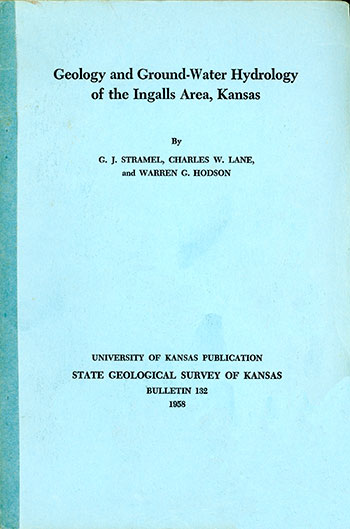Geology and Ground-water Hydrology of the Ingalls Area, Kansas
by C. J. Stramel, Charles W. Lane, and Warren C. Hodson
U. S. Geological Survey

Prepared by the State Geological Survey of Kansas and the United States Geological Survey, with the co-operation of the Division of Sanitation of the Kansas State Board of Health, the Division of Water Resources of the Kansas State Board of Agriculture, and the United States Bureau of Reclamation.
Originally published in 1958 as Kansas Geological Survey Bulletin 132. This is, in general, the original text as published. The information has not been updated. An Acrobat PDF version (15 MB) is also available. Plates available separately.
Abstract
This report describes the geology and ground-water hydrology of a 540-square-mile area in Finney and Gray Counties, Kansas. The city of Ingalls is approximately in the center of the area, which is in the Finney lowland and High Plains physiographic provinces and is crossed by Arkansas River. The normal annual precipitation is 19.93 inches, and the mean annual temperature is 55° F.
The rocks exposed in the Ingalls area are sedimentary and range in age from Tertiary to Recent. The geology of the area is described, and cross sections show the extent of the unconsolidated deposits in the subsurface. These unconsolidated deposits are about 140 to 300 feet thick and yield water to wells for all public, domestic, stock, and most irrigation supplies in the area. The quantity of water in storage in that part of the area that is 10 miles wide and 24 miles long and lies adjacent to Arkansas River between Pierceville and Cimarron amounts to about 130,000 acre-feet in the alluvium of Arkansas River and about 2,700,000 acre-feet in the Ogallala formation beneath and adjacent to the alluvium. The ground water in most of the area is moderately hard, and the water of Arkansas River and the alluvium north of the river is very hard.
Data collected from seven aquifer tests and analyses of the data are included in this report. Three aquifer tests were made of the alluvium of Arkansas River and four of the Ogallala formation. The coefficient of transmissibility of the alluvium computed from the test data ranged from 97,000 to 180,000 gpd per foot and of the Ogallala formation from 12,000 to 61,000 gpd per foot. The storage coefficient of the Ogallala formation is about 2.5 x 10-4.
The hydrologic and geologic data on which this report is based include records of 231 wells and test holes, logs of 89 wells and test holes, and analyses of 14 samples of water.
Kansas Geological Survey, Geology
Placed on web Sept. 10, 2017; originally published July, 1958.
Comments to webadmin@kgs.ku.edu
The URL for this page is http://www.kgs.ku.edu/Publications/Bulletins/132/index.html